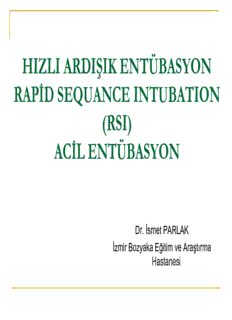
(rsı) acil entübasyon PDF
Preview (rsı) acil entübasyon
HIZLI ARDIŞIK ENTÜBASYON RAPİD SEQUANCE INTUBATION (RSI) ACİL ENTÜBASYON Dr. İsmet PARLAK İzmir Bozyaka Eğitim ve Araştırma Hastanesi Sunu planı 4 olgu senaryosu Hızlı Ardışık Entübasyonda kullanılan medikasyonlar Uygulamalardaki dikkat çekici noktalar Literatürdeki Yenilikler Özet Kaynaklar; Pubmed, Uptodate, Coohrane Library Database Syst Rev. 2008 Apr 16;(2):, Tintinalli 2004 6.baskı Son gelişmeler ışıgında yorumlarımız Bu yayın periprosedürel risk temelinde spesifik teknikler hakkında tavsiyeler ve oksijen uygulamasına pulse oksimetrik cevaba göre risk yönetiminden bahsetmektedir Am J Emerg Med. 2013 Sep;31(9):1376-81. doi: 10.1016/j.ajem.2013.06.018. Epub 2013 Jul 29. Factors associated with successful second and third intubation attempts in the ED. Kim JH1, Kim YM, Choi HJ, Je SM, Kim E; Korean Emergency Airway Management Registry (KEAMR) Investigators. Abstract PURPOSE: The aim of this study was to identify the factors associated with successful second and third attempts in adults following a failed first intubation attempt in the emergency department (ED). METHODS: This was a retrospective analysis of the data from a multicenter, prospective, observational airway registry in South Korea. We obtained demographic and clinical data of intubated adult patients in 6 academic EDs from January 2007 to December 2010. The primary outcome was successful rescue attempt, which was defined as the successful placement of an endotracheal tube following a failed first intubation attempt. Logistic regression analyses were conducted to develop a multivariate model identifying factors associated with successful second and third attempts. RESULTS: Of 5905 adult patients, 1122 (19.0%) failed a first intubation attempt. The success rates of the second and third attempts were 79.2% and 78.5%, respectively. In the multivariate logistic regression analysis, factors associated with a successful second attempt were emergencyphysicians, senior physicians, nondifficult airway, and the use of a rapid sequence intubation (RSI) (odds ratio = 2.81 [95% confidence interval, 1.80-4.37], 1.50 [1.10-2.07], 2.15 [1.53-3.01], and 1.53 [1.01-2.33], respectively). Nondifficult airway and the use of RSI were associated with successful third attempts (5.48 [2.69-11.18] and 2.63 [1.08-6.40], respectively). CONCLUSIONS: Nondifficult airway and the use of RSI were associated with successful second and third intubation attempts. The use of RSI, backup by experienced senior physicians, and preparation for management of a difficult airway could be strategies for successful rescue intubation attempts in the ED. Son yayınların ışığı altında yorumlar Hastanın baş boyun pozisyonu Preoksijenasyonun önemi Denitrijenasyon Ortalama hava yolu basıncını arttırmak için pozitif basınçlı aletlerin kullanılması Entübasyon sırasında pasif apneik oksijenasyon Hızlı ardışık entübasyon yapılacak hastalar hipoksemik hipoksi riski altındadır Özellikle bu risk kimlerde daha fazladır ??? Hipoksemik hipoksi riski altındaki hastalar Primer Akc patolojisi olan hastalar Yüksek metabolit ihtiyacı olan hastalar Anemik hastalar Solunum yetmezliği olan hastalar Aspirasyon riski olan hastalar Ancak çogu zaman bu bilgilerin hiçbirini elde edemeden hasta entübe edilmek zorunda kalınır Temel bilgiler Hastaların entübasyon sırasındaki oksihemoglobin saturasyonu %70 in altına indiği an risklerimiz artar Hangi riskler bizi bekler ????
Description: